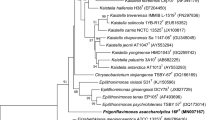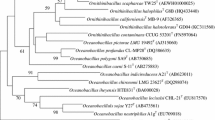Abstract
The nameKlebsiella ornithinolytica sp. nov. is proposed for a group ofKlebsiella strains referred to previously as NIH Group 12 at the National Institute of Health, Tokyo. The members of this species are Gram-negative, encapsulated, nonmotile rods with the general characteristics of the familyEnterobacteriaceae and of the genusKlebsiella. They give positive results in tests for indole production, Voges-Proskauer, citrate utilization, lysine and ornithine decarboxylases, urease, β-galactosidase, malonate utilization, growth in KCN, and esculin hydrolysis, and they produce acid and gas fromd-glucose, and acid froml-arabinose, cellobiose, lactose, melibiose, raffinose, rhamnose, sucrose, trehalose,d-xylose, adonitol,d-arabitol, myo-inositol, sorbitol, arbutin, salicin, α-methyl-d-glucoside, and mucate. They give negative drolysis, DNase, pectinase, and acid production fromd-arabinose, melezitose, and dulcitol. They can grow at 4°C and 42°C, and do not produce any pigment. DNA relatedness of eight strains ofKlebsiella ornithinolytica to three strains including the type strain of this species averaged 88% in reaction at 75°C. DNA relatedness to the already recognizedKlebsiella species inEnterobacteriaceae was 1 to 20%. Phenotypic and DNA relatedness data also indicated that a group of organisms referred to as Enteric Group 47 orKlebsiella Group 47 at the Centers for Disease Control (Atlanta, Georgia) was identical withK. ornithinolytica. The type strain ofK. ornithinolytica is NIH 90-72 (JCM 6096).
Similar content being viewed by others
Literature Cited
Cowan ST (1974) Cowan and Steel's Manual for the Identification of Medical Bacteria, 2nd edn. London: Cambridge University Press
Ewing WH (1986) Edwards and Ewing's Identification ofEnterobacteriaceae, 4th edn. New York: Elsevier
Farmer III JJ, Davis BR, Hickman-Brenner FW, McWhorter AC, Huntley-Carter GP, Asbury MA, Riddle C, Wathen-Grady HC, Ellis PB, Fanning GR, Steigerwalt AG, O'Hara CM, Morris GK, Smith PB, Brenner DJ (1985) Biochemical identification of new species and biogroup ofEnterobacteriaceae isolated from clinical specimens. Clin Microbiol 21:46–76
Johnson JL (1981) Genetic characterization. In: Gerhalt P et al. (eds) Manual of methods for general bacteriology. Washington DC: American Society for Microbiology, pp 450–472
Killian M, Bülow P (1976) Rapid diagnosis ofEnterobacteriaceae: I. Detection of bacterial glycosidases. Acta Pathol Microbiol Scand B84:245–251
Korth H, Ørskov I, Pulverer G (1969) FarbstoffbildendeKlebsiella-Stämme. Zbl Bakt Hyg I Abt Orig 211:105–107
Kosako Y, Sakazaki R, Yoshizaki E (1984)Yokenella regensburgei sp nov, gen nov: a new genus and species in the familyEnterobacteriaceae. Jpn J Med Sci Biol 37:117–124
Owen RJ, Hill LR, Lapage SP (1969) Determination of DNA base composition from melting profiles in dilute buffers. Biopolymers 7:503–516
Véron M (1975) Nutrition ét taxonomie des énterobactériés: I. Methodé d'étude des auxanogrammes. Ann Microbiol (Inst Pasteur) 126A:267–274
Author information
Authors and Affiliations
Rights and permissions
About this article
Cite this article
Sakazaki, R., Tamura, K., Kosako, Y. et al. Klebsiella ornithinolytica sp. nov., formerly known as ornithine-positiveKlebsiella oxytoca . Current Microbiology 18, 201–206 (1989). https://doi.org/10.1007/BF01570291
Issue Date:
DOI: https://doi.org/10.1007/BF01570291




